Coming Attractions
By Richard von Busack
THE BEST movie posters trap the essence of a film in one oversized image, and all a real fan needs to see is the poster to remember the entire film: how it played, how it sounded, how it felt to watch it. Of all the foolish things people collect--antique glass resistors from telephone poles, for example--movie posters have never seemed silly to me. People who seek them out and pay money for them hope to pin down something especially intangible: the emotions they experienced on seeing a particularly well-loved movie.
John Alvin is the one of the few people in show business whose work almost never disappoints. That's because he's the man who paints the movie posters, and his posters are almost always better than the movies themselves.
Alvin demurs when faced with that compliment. "Sometimes, it is the case," he says judiciously, "but then again, certain movies have reputations that precede them. They could open without a poster." Alvin, who appears at the San Jose Convention Center this Saturday as part of a show of movie memorabilia, lists dozens of credits: everything from Young Frankenstein to the Disney The Hunchback of Notre Dame.
The artist got his start in a transitional period in the history of movies, when the big studios were closing down and advertising campaigns were no longer being conducted from within the studio's publicity departments. The early 1970s ushered in, for a time, more intimate pictures. Alvin's work depends less on the carny-style pitching and the hyperbole we expect from the classic movie poster. Posters used to shout out the magnificence of a movie to the heavens. Alvin's posters, in a more modern mode, tantalize.
Alvin is a master of the tease, whether in shadowing the faces of the stars for the poster of Ironweed or concealing Gizmo the Gremlin in a box on that film's poster. The artist came up with the Michelangelo pastiche for the E.T. poster; he's done both acclaimed movies (Rain Man and the re-release of Lawrence of Arabia) and disasters (Rhinestone, The Pirate Movie). Alvin is surprised to think that he's been illustrating movie posters for 20 years.
About 25 years ago, Alvin was an art-school student studying advertising design and illustration. "Most grads headed for New York," he recalls. "I felt that there had to be work on the West Coast, since it was an entertainment capital." After graduation, Alvin worked for one season at Hanna-Barbera; then, through a friend, he got a job doing the poster art for Blazing Saddles.
The deadlines and the increased dependence on the high-concept ad campaign have complicated his work. "There's never enough time to do it right. Trying to creating a masterpiece overnight is ridiculous. I'm sometimes shocked at the requests that are made of me, and then it's my job to be honest and say that I won't do that. Some of the oddest requests come out of the corporate level."
Depending on the project, Alvin works from scripts or finished films. "Usually, there is some footage to see, some sense of the rhythm and pace. There's always an abundance of still material, a lot of visual reference. Sometimes, the idea for the image is instantaneous; sometimes, it takes agonizing days. Often, someone in marketing has an idea but doesn't have any idea how to implement it and needs someone like me to make it visual. It's much more collaborative art sometimes than it is one man's process."
And yet there have been distinguished individual figures in the art of movie postering. "Two of my greatest influences are Richard Amsel and Bob Peak," Alvin says. Amsel did many TV Guide covers, but he is best remembered for his Indiana Jones posters. They're earth-toned instead of painted in the brightly colors we expect from a movie poster. (There's an old art-school maxim: If you can't make it good, make it red). Amsel's warm, weathered posters convey the two salient points of the Indiana Jones adventures: their old-time action and their nostalgia.
As for Peak, Alvin states, "Bob Peak was the most powerful influence on movie advertising. He's known for such fabulous pieces as My Fair Lady and Camelot."
Peak's poster for Camelot is an excellent example of how a poster can outstrip a movie. It used autumnal colors--mauve, gold and rust--to illuminate realistic but two-dimensional cartoons of stars Richard Harris and Vanessa Redgrave. In Peak's image, the two were not larger-than-life heroes but flat and stylized. Peak could be called the conduit through which Andy Warhol's sensibility entered the art of the movie poster.
"Because of Peak and Amsel," says Alvin, "more creative avenues opened for people like myself. Amsel did some of the early Star Trek film posters. When I was asked to do the poster for Star Trek VI in the style of Amsel's posters for the first few Star Trek films, I was honored to do so."
Though Alvin is famous for his fantasy, animation and science-fiction posters, he says, "To tell you the truth, I'm not as much of a fan as some of the fans that attend the convention. I've always enjoyed science fiction on an artistic level. I wouldn't say I'm a fan, but I would say I'm in tune to the better science-fiction movies."
Alvin says he enjoys getting recognition at conventions for the art he does almost anonymously. "I really ought to feel that an artist's signature should be discreet, but half of my pieces are signed. You can see my signature on an angle at the side of a building in Blade Runner and underneath the circumference of the earth on E.T. Other times, I'm asked, or paid, not to sign the art. Obviously, I prefer the latter. Sometimes, I will hide my signature in the art work. Some of the older pieces, if viewed upside down or in a mirror, reveal something."
ALVIN IS currently working on two posters. "Two different projects, major projects for major studios," he says with a conspiratorial air, "but I'm not free to talk about them, though I wish I was. You know how secretive our greatest filmmakers have been; I think that the studios are taking a cue from that."
Asked if there is a deeper meaning to his work, Alvin says, "If I have a philosophy about all this--and I may not in the position to have that luxury--a poster should make a promise of a great time, a great emotional experience. The movie should deliver on the promise, but all the poster artist can do is hope they will deliver on it."
Alvin runs a small company with a big reputation. "My wife and I work here with a few freelancers," he explains, "and, of course, our Macintoshes. We're working as traditionally trained artists with an eye to the digitally oriented world. The computer is a fabulous tool, but it's not going to replace the traditional artist. No matter what computer you have, there's no button that says, 'good taste.' "
[ Metro | Metroactive Central | Archives ]
This page was designed and created by the Boulevards team.
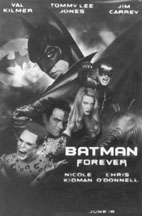
No, but I Saw the Poster: John Alvin's dynamic stylish design for the "Batman Forever" poster easily outstrips an indifferent summer blockbuster.
From 'Blade Runner' to 'Batman Forever,' poster artist John Alvin captures the soul of a film in a single, unforgettable image
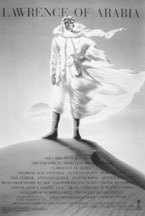
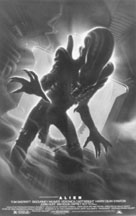
Creature Feature: The European poster art for "Alien" featured Alvin's brooding beast emerging from the gloom.
Alvin has seen the business change from the movie studios to communications corporations. "Shall we say, it's more complex now," he offers diplomatically. "Sometimes, that works in the favor of the artist; other times, it's a veritable quagmire. I have seen what used to be called the ad department become what is now invariably called a marketing department. I'm not sure I understand the name change, but it is a harbinger of complexity. Fair being fair, I have to say that it is also far more complex to sell a movie now than it used to be."
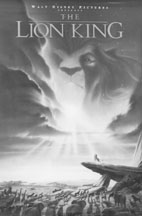
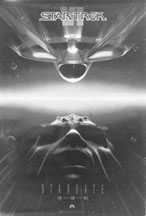
The Hollywood Show of television and movie memorabilia takes place Saturday (Sept. 7), 10:30am5pm, at Parkside Hall, the San Jose Convention Center, Market and San Carlos streets, San Jose. Admission is $5. (408/993-0116, or 408/993-0294; HStore@AOL)
From the September 5-11, 1996 issue of Metro
Copyright © 1996 Metro Publishing, Inc.
![[Metroactive Arts]](/arts/gifs/art.gif)